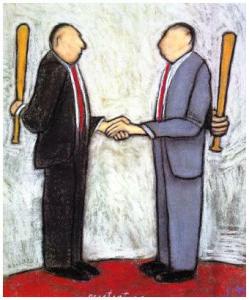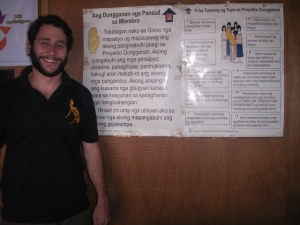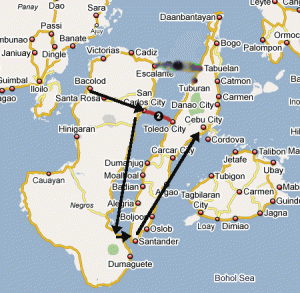This weekend I went to Cebu, an island east of Negros, for the Kiva rollout in the NWTF branches. I figured the place would be ideal for my photography, especially since I’d gotten hold of the best dslr under $1000 that one could lay their hands on. I traveled as part of a five-person team, including Massah, the photography consultant, Raymond, the research manager, Jubert, the IT manager, and Presy, the Kiva coordinator. Pocholo, a friend of Raymond’s, needed a lift to Cebu and caught a ride with us. The six of us loaded the infamous red van and left at 7 AM on Thursday morning. The road to the port in San Carlos normally takes 3.5 hours, but we chose to take a shortcut through the mountains on a winding two-lane road cut neatly into the side of a cliff. Unfortunately, by the time we arrived at the port, the ferry was full. The next ferry didn’t leave until 2:30 in the afternoon, so we drove three hours south along a coastal road to another port in Aclan, where the ferry leaves every hour and takes 30 minutes to cross. Once on the other side, we had another three-hour trip back up north. Twelve hours later, we arrived in Cebu City and checked into a hotel.
Category Archives: Travel and Culture
I’m Changing Photo Sites
The suits over at Yahoo have informed me that I’ve reached my 200-photo limit on my Flickr account. For unlimited storage space, the capitalists are asking for $24.95 per year. In protest, I am moving all my pictures to Picasa, Google’s free photo uploader. I will continue to upload new photos to Flickr, with the link displayed in the sidebar. But for the full collection of photos, check the Picasa site, which also has a link on the sidebar. Click on the photo below to reach the new site:
Also, don’t forget to sign up to have your daily dose of Microsteinance delivered direct to your email.
Another Trip
 Capping off a marathon month of travel, I am spending the weekend in Cebu. NWTF is rolling out Kiva in several of the Cebu branches and I am coming along to give a short presentation to the loan officers and branch manager on the history of Kiva, the mission, and how it works. There will be five of us, including myself. The Kiva coordinator, Presy, will discuss the process for getting the information for the borrower profile. The MIS manager, Jubert, will talk about using the technology (FTP, or file transfer protocol) to send the data to headquarters. Raymond, the assistant manager of the research department, will explain why NWTF chose to partner with Kiva – what value the Kiva brings and how NWTF benefits. Lastly, Massah, a freelance consultant and graduate of UCLA film school, will give the loan officers a training on how to take photos and video. It should be an interesting experience.
Capping off a marathon month of travel, I am spending the weekend in Cebu. NWTF is rolling out Kiva in several of the Cebu branches and I am coming along to give a short presentation to the loan officers and branch manager on the history of Kiva, the mission, and how it works. There will be five of us, including myself. The Kiva coordinator, Presy, will discuss the process for getting the information for the borrower profile. The MIS manager, Jubert, will talk about using the technology (FTP, or file transfer protocol) to send the data to headquarters. Raymond, the assistant manager of the research department, will explain why NWTF chose to partner with Kiva – what value the Kiva brings and how NWTF benefits. Lastly, Massah, a freelance consultant and graduate of UCLA film school, will give the loan officers a training on how to take photos and video. It should be an interesting experience.
She Drives a Dodge Stratus: The Role of the Husband
One of microfinance’s major achievements has been to empower women in societies that relegate women to a second-class status. At Negros Women for Tomorrow, 98% of clients are women. The rationale behind lending to women is that they are more reliable, family-oriented, and stationary. Women are more likely to spend the money on things like education and health care. One of the major themes of this blog is to highlight the interconnectedness of the impacts of microfinance. Giving women a livelihood pays dividends.
Empowering women to start a business not only gives them the respect that comes with being the breadwinner, but also makes them more influential in decisions made in the home and reduces their dependence on a partner. A widow that has relied on her husband will be reduced to poverty without grown children to support her. If having a large family was once a retirement plan, giving women a source of income could have positive ramifications for family planning. These are only a few of the examples of the benefits of empowering women. The effectiveness of microfinance at achieving this end is often disputed. In my experience, it is something very real and apparent. The degree to which microfinance has contributed is certainly open to debate. However, this post is not about women’s empowerment. It is about the role of the husband in making microfinance effective. Continue reading
Beard Update
It’s been over a month since my last update about the beard. Unfortunately, I wish I could say that no news is good news, because the news is all bad. The pattern highlighted in my previous post has shown itself to be permanent – disappointing to say the least. This is Asia and few people can grow beards here. I went on a trip with one of my coworkers and his friends to Dumaguete, a beach town down south that is also the capital city of Negros Oriental. In this picture, I am shown with the only Filipino in the entire island of Negros that is capable of growing a beard. The entire week we were referred to as the terrorists. Because the market for the products doesn’t exist, I don’t have access to the proper grooming tools, so I’ve been using a mustache trimmer to keep the beast in check. It has worked reasonably well, apart from the errant bare patch. But first, the developments. Continue reading
Two Days in La Castellana
 Last week, I spent two days in the town of La Castellana, visiting the NWTF branch here. I went to speak with existing Kiva clients about their business to send an update to the lenders, and also interview new clients to post up on the site. You can always tell the profiles and updates I’ve written because I try to employ the same literary techniques that make this blog so readable (or unreadable, depending on your perspective). Of the six weeks I have been working here, I’ve spent two and a half in the field. This is where I get to see microfinance implemented on the ground. I get to see the how it is executed and talk to the loan officers and the clients – the people in the proverbial shit. It is the part of the job I enjoy the most.
Last week, I spent two days in the town of La Castellana, visiting the NWTF branch here. I went to speak with existing Kiva clients about their business to send an update to the lenders, and also interview new clients to post up on the site. You can always tell the profiles and updates I’ve written because I try to employ the same literary techniques that make this blog so readable (or unreadable, depending on your perspective). Of the six weeks I have been working here, I’ve spent two and a half in the field. This is where I get to see microfinance implemented on the ground. I get to see the how it is executed and talk to the loan officers and the clients – the people in the proverbial shit. It is the part of the job I enjoy the most.
The day begins early. I’m told I need to be ready to go by 5:45, so I set my alarm for 5:00. At 5:30, I get a knock on the door. It is Albert, one of the janitors, who is supposed to take me to the bus stop a kilometer away. Fresh out of the shower, I asked for 5 minutes to gather my things before we left. When we get to departure point for the van, the gate is closed. Albert yells to the driver, who is sleeping in the rundown ticket office. He rubs his eyes, with haunting blue lenses contacts, gets up and walks over to the van (inside the gate). He says something to Albert in Ilonggo, climbs into the backseat of the van and falls asleep on the seat. “The van doesn’t leave until 6:15,” Albert tells me. I told him to go ahead, and that I can wait on my own. Continue reading
New Photos
Check out the new photos from my weeklong trip to Capiz province and visit to the La Castellana branch of Negros Women for Tomorrow.
Baudelaire and the Red Horse
It is the greatest art of the devil to convince us he does not exist. – Charles Baudelaire, 1821-1867
Here in the Philippines, the brewery is called San Miguel. Founded in 1890, the company employs 26,000 people and holds 90% of the Philippine market. The largest brewery in the country is right here in Bacolod, so there is a lot of San Miguel pride. There are three main brands – the San Mig Light, the Pale Pilsen, and the Red Horse. The first two are perfectly acceptable choices in any situation, particularly for the health-conscious traveler that wants to mitigate the fried pork’s feet. In fact, as long as a food is small enough to fit in the pan, Filipinos will fry it. If it is too big, they will cut it into two pieces and fry both. But this is besides the point. The third beer, Red Horse, is affectionately known as the Water of the Devil. It is truly a horse of a different color – a poisonous, deadly color. It is the color of blood and fire. Brewed deep in the pits of hell by the lost souls cast down after being bucked from the stallion, the Horse boasts a beastly 7% alcohol content. Few among the living have entered the ring with the horse and left with their dignity intact. Continue reading
Photo Gallery
Deal or No Deal
 Anyone who has been to Southeast Asia (or anywhere outside the United States and Europe) knows that the price you are given by a vendor is not the price you are going to pay. That is because we Westerners are an easy mark, perceived as a walking ATM machine that doesn’t know any better than to pay what they ask. I’ve become a spendthrift since I arrived here, becoming agitated when I find a restaurant down the block that serves rice for a dollar or two cheaper than the one I just patronized. When the proverbial spigot is turned off, you become acutely sensitive to the thickness of your wallet. All this is a way of saying I try to bargain as often and as hard as I can. I now have experience negotiating with people in three countries, all of which have a different profile. But first, the rules.
Anyone who has been to Southeast Asia (or anywhere outside the United States and Europe) knows that the price you are given by a vendor is not the price you are going to pay. That is because we Westerners are an easy mark, perceived as a walking ATM machine that doesn’t know any better than to pay what they ask. I’ve become a spendthrift since I arrived here, becoming agitated when I find a restaurant down the block that serves rice for a dollar or two cheaper than the one I just patronized. When the proverbial spigot is turned off, you become acutely sensitive to the thickness of your wallet. All this is a way of saying I try to bargain as often and as hard as I can. I now have experience negotiating with people in three countries, all of which have a different profile. But first, the rules.
You are not supposed to enter into a negotiation unless you have the intention of buying something, as it is considered bad etiquette. Only start the bargaining process if you actually have some interest in buying the product. I learned this the hard way in Vietnam, where I got some dagger-esque stares after walking away from a potential Brazilian football (soccer) jersey deal. Also, remember the context of the situation. You are representing your country, and probably make more in a day than the people you are bargaining with make in a month. I am the exception, of course, since I have a steady income of $0.00 per month. Still, while it is fine to bargain, it’s not always important to get the product for just over cost. You don’t want to rake them over the coals and, in the process, reinforce a stereotype about your country being cheap. Remember to smile and keep it reasonably lighthearted. You will probably get a better deal that way anyways. I started to read about Rational Choice Theory, Pareto optimality, and Nash bargaining solutions in preparation for this section of the article, but the opportunity cost of teaching myself game theory is too high. As much as I’d like to learn about the mathematical theories behind bargaining, it’s going to have to take it’s place at the back of the line. Now to the differences. Continue reading








